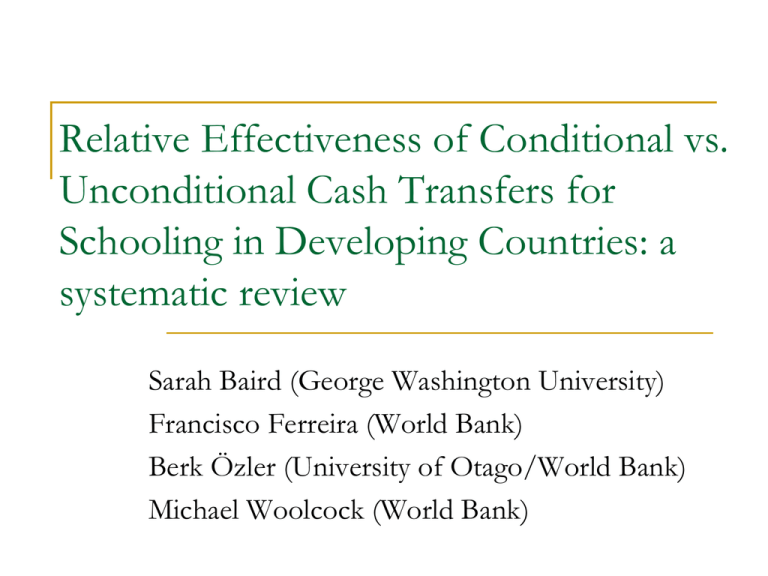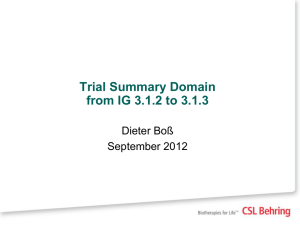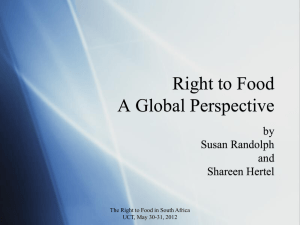CCTs vs UCTs in Education - The Campbell Collaboration
advertisement

Relative Effectiveness of Conditional vs. Unconditional Cash Transfers for Schooling in Developing Countries: a systematic review Sarah Baird (George Washington University) Francisco Ferreira (World Bank) Berk Özler (University of Otago/World Bank) Michael Woolcock (World Bank) Outline Background & objectives Search strategy & selection criteria Data collection & analysis Main Results Authors Conclusions Acknowledgements & Funding 2 BACKGROUND AND OBJECTIVES 3 Background Increasing educational attainment around the world is one of the key aims of the Millennium Development Goals There are many social protection programs in developing countries that aim to improve education Conditional Cash Transfers (CCTs) are “… targeted to the poor and made conditional on certain behaviors of recipient households.” As of 2007, 29 countries around the world had some type of a Conditional Cash Transfer program (CCT) in place, with many others planning or piloting one (World Bank, 2009) Unconditional Cash Transfer programs (UCT) are also common and have also been shown to change behaviors on which CCTs are typically conditioned. 4 Figure 1: Theory of change for schooling conditional cash transfers and unconditional cash transfers on schooling outcomes Intervention A Input Immediate Change Unconditional Cash Transfer Cash Income Intermediate Outcomes: Immediate Change Intervention B Input Schooling Conditional Cash Transfer Cash IF meet condition School Attendance School Enrollment Final Outcomes: Test Scores Income Relative price of Schooling (subsitution effect) Moderating Factors: Enforcement of condition (CCT only), transfer size, baseline enrollment rate, transfer recipient, program size 5 Background The debate over whether conditions should be tied to cash transfers has been at the forefront of recent global policy discussions. The main argument for UCTs is that the key constraint for poor people is simply lack of money (e.g. because of credit constraints), and thus they are best equipped to decide what to do with the cash (Hanlon, Barrientos and Hulme 2010). Three main arguments for CCTs: market failure that causes suboptimal levels of education; investments in education below socially optimal level; political economy. 6 Objectives This systematic review aims to complement the existing evidence on the effectiveness of these programs and help inform the debate surrounding the design of cash transfer programs. Our main objective was to assess the relative effectiveness of conditional and unconditional cash transfers in improving enrollment/dropout, attendance and test scores in developing countries. Our secondary objective was to understand the role of different dimensions of the cash transfer programs including: Role of the intensity of conditions Transfer size Baseline enrollment 7 SEARCH STRATEGY AND SELECTION CRITERIA 8 Search Strategy Five main strategies were used to identify relevant reports (1) Electronic searches of 37 international databases (concluded on April, 18 2012) (2) contacted researchers working in the area (3) hand searched key journals (4) reviewed websites of relevant organizations (5) given the year delay between the original search and the final edits of the review we updated our references with all new eligible references the study team was aware of as of April 30, 2013. 9 Eligible Reports Report had to either assess the impact of a conditional cash transfer program (CCT), with at least one condition explicitly related to schooling, or evaluate an unconditional cash transfer program (UCT). The report had to include at least one quantifiable measure of enrollment, attendance or test scores. The report had to be published after 1997 The report utilize a randomized control trial or a quasiexperimental design. The report had to take place in a developing country. 10 11 DATA COLLECTION AND ANALYSIS 12 Calculating Effect Sizes Measures of treatment effects come from three different types of studies: CCT vs. control, UCT vs. control, and, for four experimental studies, CCT vs. UCT. For these latter set of studies, a separate effect size for CCT and UCT (each compared with the control group of no intervention) is constructed. We construct odds ratios for effect size measures of enrollment and attendance, and report test score results in standard deviations. Economists typically do not report the ideal level of information, almost exclusively use cluster designs, and there are multiple reports per study, as well as multiple measures per report. 13 Calculating Effect Sizes We define an intervention to be a UCT or a CCT. We define a study to be a different version of a UCT or a CCT (or in a few experiments a UCT and a CCT) implemented in different places For many of these studies, there are multiple publications (journal articles, working papers, technical reports, etc.). We refer to these as reports. In our meta-analysis, the unit of observation is the study. This means that we would like to construct one effect size per study for the overall effect on any of our three outcome variables and for each subgroup (if reported). 14 Calculating Effect Sizes For each subgroup, we construct one effect size by synthesizing and summarizing multiple effect sizes within each report, then again synthesizing and summarizing those combined effect sizes from different reports within a study. We create synthetic effects when the effect sizes are not independent of each other. This is the case when there are multiple effects reported for the same sample of participants. These effects are combined using a simple average of each effect size (ES) and the variance is calculated as the variance of that mean with the correlation coefficient r assumed to be equal to 1 When two or more ES are independent of each other, we create summary effects. To combine these estimates into an overall estimate (or an estimate for a pre-defined subgroup), we utilize a random effects (RE) model. 15 MAIN RESULTS 16 Results of the search 75 reports were included in our review. Table 4: Characteristics of analysis sample Panel A: Reference level characteristics: (N=75) Number Publication type: Journal article 33 Working paper 27 Technical Reports 10 Dissertation 4 Unpublished 1 Reports effects on: Enrollment/Dropout 67 Attendance 17 Test Score 12 % 44.00% 36.00% 13.33% 5.33% 1.33% 89.33% 22.67% 16.00% 17 Results of the search Panel B: Study level characteristics, binary (N=35) Number % UCT 5 14.29% CCT 26 74.29% UCT/CCT 4 11.43% Regional Distribution Latin America and the Caribbean 19 54.29% Asia 8 22.86% Africa 8 22.86% Female recipient 16 45.71% Pilot Program 9 25.71% Random Assignment 12 34.29% Panel C: Study level characteristics, continuous (N=35) Mean Std 0.785 0.146 Control Follow-up Enrollment Rate 2.17 2.360 # of Reports per Study 8.24 4.020 Transfers per Year 5.66 7.890 Transfer amount (% of HH Income) 351 414 Annual per Person Cost (USD) 18 Program Name UCT Social Cash Transfer Scheme Child Support Grant CT-OVC Old Age Pension Program Old Age Pension SIHR Nahouri Cash Transfers Pilot Project Tayssir Subtotal (I-squared = 52.2%, p = 0.041) . CCT Social Risk Mitigation Project Program Keluarga Harapan (KPH) Bono Juancito Pinto Conditional Subsidies for School Attendance Chile Solidario Ingreso Ciudadano Oportunidades Familias en Accion Bono de Desarrollo Juntos Japan Fund for Poverty Reduction Tayssir Jaring Pengamanan Sosial (JPS) PRAF II Pantawid Pamilyang Pilipino Program PROGRESA Nahouri Cash Transfers Pilot Project Tekopora Female Secondary Stipend Program Red de Opportunidades Bolsa Escola Bolsa Familia SIHR CESSP Scholarship Program China Pilot Comunidades Solidarias Rurales Red de Proteccion Social Subtotal (I-squared = 86.5%, p = 0.000) . Overall (I-squared = 84.5%, p = 0.000) Odds Ratio (95% CI) Country Malawi South Africa Kenya South Africa Brazil Malawi Burkino Faso Morocco 1.04 1.04 1.11 1.15 1.15 1.30 1.31 1.59 1.23 (0.82, (0.53, (0.84, (0.82, (0.96, (0.96, (0.94, (1.38, (1.08, 1.31) 2.04) 1.47) 1.62) 1.38) 1.75) 1.83) 1.85) 1.41) Turkey Indonesia Bolivia Colombia Chile Uruguay Mexico Colombia Ecuador Peru Cambodia Morocco Indonesia Honduras Philipines Mexico Burkino Faso Paraguay Bangladesh Panama Brazil Brazil Malawi Cambodia China El Salvador Nicaragua 0.72 0.98 1.02 1.05 1.22 1.25 1.25 1.29 1.30 1.33 1.34 1.40 1.42 1.45 1.48 1.48 1.50 1.53 1.74 1.85 1.90 1.96 1.98 2.72 2.74 3.78 4.36 1.41 (0.47, (0.95, (0.92, (0.96, (1.00, (0.87, (1.09, (1.06, (1.07, (1.16, (0.95, (1.20, (1.19, (1.20, (0.80, (1.27, (1.03, (0.72, (1.10, (1.23, (1.01, (0.82, (1.53, (1.92, (1.18, (1.62, (2.08, (1.27, 1.11) 1.02) 1.14) 1.16) 1.50) 1.79) 1.43) 1.56) 1.57) 1.53) 1.88) 1.64) 1.70) 1.75) 2.73) 1.72) 2.17) 3.24) 2.77) 2.80) 3.58) 4.66) 2.57) 3.87) 6.37) 8.82) 9.11) 1.56) 1.36 (1.24, 1.48) .5 intervention reduces enrollment 1 1.5 2 3 4 intervention increases enrollment 19 Table 10: Summary of Findings (Enrollment) Odds of Child Being Enrolled in School: CCT vs. UCT Statistically Significant?* # Effect Sizes* Overall (vs. Control) UCT (vs. Control) 36% higher 23% higher Yes 35 Yes 8 CCT (vs. Control) CCT (vs. UCT) 41% higher 15% higher Yes No 27 35 18% higher Yes 6 Condition Enforcement No Schooling Condition (vs. Control) Some Schooling Condition (vs. Control) Explicit Conditions (vs. Control) Intensity of Condition Comments Our analysis of enrollment includes 35 effect sizes from 32 studies. Both CCTs and UCTs significantly increase the odds of a child being enrolled in school, with no significant difference between the two groups. This binary distinction masks considerable heterogeneity in the intensity of the monitoring and enforcement of the condition. When we further categorize the studies, we find a significant increase in the odds of a child being enrolled in school as the intensity of the condition increases. In addition, studies with explicit conditions have significantly larger effects than studies with some or no conditions. Yes 14 25% higher Yes 15 60% higher Increases by 7% for each unit increase in Yes 35 intensity of condition. Notes: We consider a study to be statistically significant if it is significant at the 90% level or higher. I use the term effect size here instead of study since the studies that directly compare CCTs and UCTs have two effect sizes in the analysis. All other studies have one. 20 CCT vs. UCT—too simplistic? Could we categorize all programs, and not just the CCTs, in order of the intensity of schooling conditionalities imposed by the administrators? 0. UCT programs unrelated to children or education – such as Old Age Pension Programs(2) 1. UCT programs targeted at children with an aim of improving schooling outcomes –such as Kenya’s CT-OVC or South Africa’s Child Support Grant 2. UCTs that are conducted within a rubric of education – such as Malawi’s SIHR UCT arm or Burkina Faso’s Nahouri Cash Transfers Pilot Project UCT arm (3) 3. Explicit conditions on paper and/or encouragement of children’s schooling, but no monitoring or enforcement – such as Ecuador’s BDH or Malawi’s SCTS (8) 21 CCT vs. UCT—too simplistic? 4. Explicit conditions, (imperfectly) monitored, with minimal enforcement – such as Brazil’s Bolsa Familia or Mexico’s PROGRESA (8) 5. Explicit conditions with monitoring and enforcement of enrollment condition – such as Honduras’ PRAF-II or Cambodia’s CESSP Scholarship Program (6) 6. Explicit conditions with monitoring and enforcement of attendance condition – such as Malawi's SIHR CCT arm or China’s Pilot CCT program (10) 22 2 1 1.5 0 Odds Ratio .5 -.5 0 2 4 6 Condition Enforced 23 Program Name Odds Ratio (95% CI) Country No Schooling Conditions Child Support Grant South Africa CT-OVC Kenya Old Age Pension Program South Africa Old Age Pension Brazil SIHR Malawi Nahouri Cash Transfers Pilot Project Burkino Faso Subtotal (I-squared = 0.0%, p = 0.950) . Some Schooling Conditions with No Monitoring or Enforcement Social Risk Mitigation Project Turkey Program Keluarga Harapan (KPH) Indonesia Bono Juancito Pinto Bolivia Social Cash Transfer Scheme Malawi Chile Solidario Chile Oportunidades Mexico Bono de Desarrollo Ecuador Juntos Peru PROGRESA Mexico Tekopora Paraguay Tayssir Morocco Female Secondary Stipend Program Bangladesh Bolsa Escola Brazil Bolsa Familia Brazil Subtotal (I-squared = 87.2%, p = 0.000) . Explicit Conditions Monitored and Enforced Conditional Subsidies for School Attendance Colombia Ingreso Ciudadano Uruguay Familias en Accion Colombia Japan Fund for Poverty Reduction Cambodia Tayssir Morocco Jaring Pengamanan Sosial (JPS) Indonesia PRAF II Honduras Pantawid Pamilyang Pilipino Program Philipines Nahouri Cash Transfers Pilot Project Burkino Faso Red de Opportunidades Panama SIHR Malawi CESSP Scholarship Program Cambodia China Pilot China Comunidades Solidarias Rurales El Salvador Red de Proteccion Social Nicaragua Subtotal (I-squared = 80.6%, p = 0.000) . Overall (I-squared = 84.5%, p = 0.000) .5 1.04 (0.53, 2.04) 1.11 (0.84, 1.47) 1.15 (0.82, 1.62) 1.15 (0.96, 1.38) 1.30 (0.96, 1.75) 1.31 (0.94, 1.83) 1.18 (1.05, 1.33) 0.72 (0.47, 1.11) 0.98 (0.95, 1.02) 1.02 (0.92, 1.14) 1.04 (0.82, 1.31) 1.22 (1.00, 1.50) 1.25 (1.09, 1.43) 1.30 (1.07, 1.57) 1.33 (1.16, 1.53) 1.48 (1.27, 1.72) 1.53 (0.72, 3.24) 1.59 (1.38, 1.85) 1.74 (1.10, 2.77) 1.90 (1.01, 3.58) 1.96 (0.82, 4.66) 1.25 (1.10, 1.42) 1.05 (0.96, 1.16) 1.25 (0.87, 1.79) 1.29 (1.06, 1.56) 1.34 (0.95, 1.88) 1.40 (1.20, 1.64) 1.42 (1.19, 1.70) 1.45 (1.20, 1.75) 1.48 (0.80, 2.73) 1.50 (1.03, 2.17) 1.85 (1.23, 2.80) 1.98 (1.53, 2.57) 2.72 (1.92, 3.87) 2.74 (1.18, 6.37) 3.78 (1.62, 8.82) 4.36 (2.08, 9.11) 1.60 (1.37, 1.88) 1.36 (1.24, 1.48) 1 intervention reduces enrollment 1.5 2 3 6 intervention increases enrollment 24 Table 10: Summary of Findings (Enrollment) Odds of Child Being Enrolled in School: CCT vs. UCT Statistically Significant?* # Effect Sizes* Overall (vs. Control) UCT (vs. Control) 36% higher 23% higher Yes 35 Yes 8 CCT (vs. Control) CCT (vs. UCT) 41% higher 15% higher Yes No 27 35 18% higher Yes 6 Condition Enforcement No Schooling Condition (vs. Control) Some Schooling Condition (vs. Control) Explicit Conditions (vs. Control) Intensity of Condition Comments Our analysis of enrollment includes 35 effect sizes from 32 studies. Both CCTs and UCTs significantly increase the odds of a child being enrolled in school, with no significant difference between the two groups. This binary distinction masks considerable heterogeneity in the intensity of the monitoring and enforcement of the condition. When we further categorize the studies, we find a significant increase in the odds of a child being enrolled in school as the intensity of the condition increases. In addition, studies with explicit conditions have significantly larger effects than studies with some or no conditions. Yes 14 25% higher Yes 15 60% higher Increases by 7% for each unit increase in Yes 35 intensity of condition. Notes: We consider a study to be statistically significant if it is significant at the 90% level or higher. I use the term effect size here instead of study since the studies that directly compare CCTs and UCTs have two effect sizes in the analysis. All other studies have one. 25 Table 11: Summary of Findings (attendance and test scores) Odds of Child # Panel A: Attendance Being Enrolled in Statistically Effect Comments School: Significant?* Sizes* A smaller number of studies assess the affect of CCTs 59% higher Yes 20 Overall (vs. Control) and UCTs on attendance compared to enrollment. Both 42% higher Yes 5 UCT (vs. Control CCTs and UCTs have a significant affect on attendance. 64% higher Yes 15 CCT (vs. Control) While the effect size is always positive, we do not detect 17% higher No 20 CCT vs. UCT (regression) significant differences between CCTs and UCTs on Intensity of Conditionality attendance. (regression) Increases by 8% for No 20 each unit increase in intensity of condition. Standard Deviation # Panel B: Test Scores Increase in Test Statistically Effect Comments Scores Significant?* Sizes* There are very few studies that analyze test scores. We 0.06 Yes 8 Overall (vs. Control) have a total of 8 effect sizes measured from 5 studies. 0.04 No 3 UCT (vs. Control CCTs significantly increase test scores, though the size is 0.08 Yes 5 CCT (vs. Control) very small at 0.08 standard deviations. We find no 0.05 No 8 impact of UCTs on test scores. Additional research on CCT vs. UCT (regression) the impact of CCTs and UCTs on test scores is needed. Intensity of Conditionality Increase of 0.02 In order to include these results in meta-analysis tests (regression) standard deviations should be conducted with the entire sample, and results for each unit No 8 presented in terms of standard deviations. increase in intensity of conditions Notes: We consider a study to be statistically significant if it is significant at the 90% level or higher. I use the term effect size here instead of study since the studies that directly compare CCTs and UCTs have two effect sizes in the analysis. All other studies have one. 26 AUTHORS CONCLUSIONS 27 Authors’ Conclusions (1) Our main finding is that both CCTs and UCTs improve the odds of being enrolled in and attending school compared to no cash transfer program. When programs are categorized as having no schooling conditions, having some conditions with minimal monitoring and enforcement, and having explicit conditions that are monitored and enforced, a much clearer pattern emerges. The pooled effect sizes for enrollment and attendance are always larger for CCT programs compared to UCT programs but the difference is not significant. The findings of relative effectiveness on enrollment in this systematic review are also consistent with experiments that contrast CCT and UCT treatments directly. While interventions with no conditions or some conditions that are not monitored have some effect on enrollment rates (18-25% improvement in odds of being enrolled in school), programs that are explicitly conditional, monitor compliance and penalize non-compliance have substantively larger effects (60% improvement in odds of enrollment). 28 Authors’ Conclusions (2) The effectiveness of cash transfer programs on test scores is small at best. Limitations: It seems likely that without complementing interventions, cash transfers are unlikely to improve learning substantively. Very few rigorous evaluations of UCTs—need more research! Study limited to education outcomes Most of the heterogeneity in effect sizes remains unexplained Not much information on cost Researchers: Report relevant data to calculate effect size (i.e. control means at baseline and follow up) Self reports vs. more objective measures. 29 Acknowledgements and Funding Thank you!! International Development Coordinating Group of the Campbell Collaboration for their assistance in development of the protocol and draft report. John Eyers and Emily Tanner-Smith as well as anonymous referees for detailed comments that greatly improved the protocol. David Wilson for help with the effect size calculations. Josefine Durazo, Reem Ghoneim, and Pierre Pratley for research assistance. Funding This research has been funded by the Australian Agency for International Development (AusAID). The views expressed in the publication are those of the authors and not necessarily those of the Commonwealth of Australia. The Commonwealth of Australia accepts no responsibility for any loss, damage or injury resulting from reliance on any of the information or views contained in this publication The Institute for International and Economic Policy (IIEP) at George Washington University also assisted with funding for a research assistant. 30





